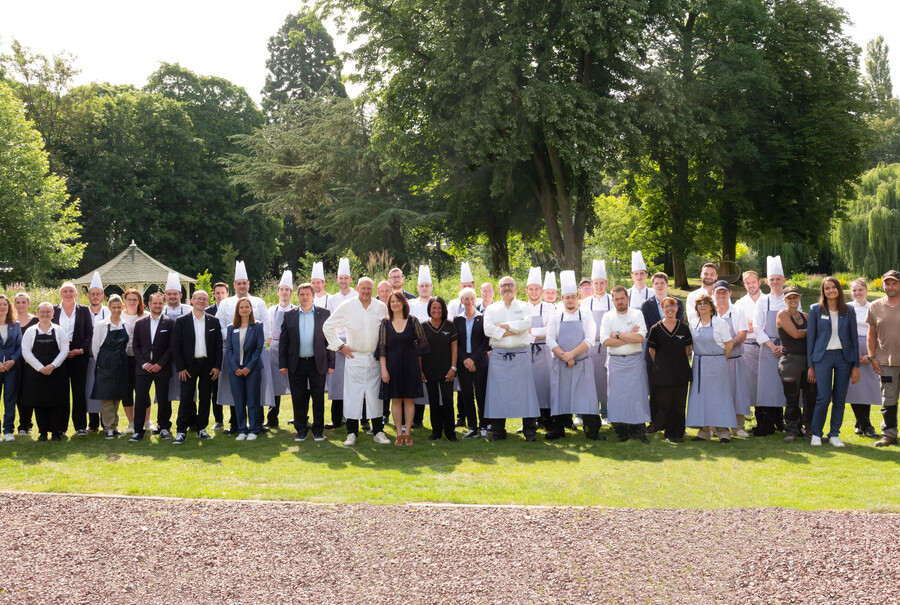- Commitments
- Saving the oceans
- Seafood with Christophe Dufossé: Cooking with Conscience
Seafood with Christophe Dufossé:
Cooking with Conscience
Labels, seasonality, stocks,... It’s easy to get tangled in the net of sustainable fishing. At Château de Beaulieu–rewarded with two Michelin stars and a Green Star in recognition of its ethical approach–chef Christophe Dufossé's respect for marine resources sets an example for all of gastronomy.

Razor clams from the Opal Coast. Surf & Turf interpretation, emulsion of beer from the Hauts-de-France with pickled chanterelles, saline glassworts, stewed Busnes shallots…
Labels, seasonality, stocks,... It’s easy to get tangled in the net of sustainable fishing. At Château de Beaulieu–rewarded with two Michelin stars and a Green Star in recognition of its ethical approach–chef Christophe Dufossé's respect for marine resources sets an example for all of gastronomy.
At what point did you realize the importance of embracing sustainable seafood?
Christophe Dufossé: JI was born in Calais, and grew up in the sea spray of the Opal Coast. When I reached the age of 50, after exploring various experiences in France and throughout the world, I decided to get back to basics and move closer to my hometown. At Château de Beaulieu, which I joined nearly two years ago, ninety per cent of the ingredients we use come from the local Hauts-de-France area. So we have a very strong relationship with the coast, which is just 25 miles away.
Where do you find reliable information about the actual populations of each species?
CD: I inquire on a case-by-case basis, keeping informed in the field and taking advice from older fishermen whose experience is precious. At times, fish is abundant, and it is considered to be ‘in season’–but in fact it is their breeding season. Flat fish are particularly vulnerable during this period, and they aren’t very satisfying to eat, either. A turbot fished during the breeding season falls apart when it is cooked. Breeding season is just not the time to fish that species. We don’t dictate what’s for dinner: the sea does.
Is there any type of seafood that you rule out, or that you buy only in small quantities because you are aware it is scarce?
CD: We never use eel or sole. There is a critical shortage in sole stocks off the coast of Boulogne, and I do not wish to source it elsewhere. That’s not an easy choice, because I have fond memories of the exquisite taste of sole meunière, a mainstay of our regional gastronomy. But we are adapting our menu, accepting that limitation, and staying flexible. Also, why would we offer lobster in the wintertime, when we have to bring it from Canada? We have to demonstrate our convictions and cultivate mutual trust with diners. And we do not prepare salmon or shrimp, both farmed species that pose major environmental issues.
Can you give us an example of a dish from your restaurant that turns the spotlight on to lesser-known species?
CD: I have a special fondness for a type of shellfish from the Opal Coast called the razor clam. I use it in a surf-and-turf dish with a Ch’ti beer emulsion. I don’t use razor clams that come from Belgium or are not fished by hand. I also love scallops from Boulogne, and I adore the red gurnard, a fish typical of our region which is exclusively caught from small boats in the North Sea. Its stocks are doing well. We also prepare fish that are not traditionally considered fancy and that tend to fall apart, such as hake. I prepare hake in two steps. First, I brine it to firm it up, then I roll it in morel powder and bake it right before serving, gradually raising the heat in the oven. That brings out the quintessence of the fish.
Left: Scallops from our local coast seared and served with chicken jus, oyster plant roasted in its peel, toasted hazelnuts, and extraction of Jerusalem artichoke.
We often hear the catchphrase “eat less, eat better” when it comes to meat, but not so much when it comes to seafood, at least for the moment. Does that resonate with you?
CD: Absolutely! When we create a menu, we bring in a lot more plant-based ingredients, both for the well-being of the person and for the balance of the meal. At Château de Beaulieu, we offer three-, five- and seven-course meals, and plant-based ingredients play a prominent role in each one. Seafood is featured in small quantities, with no more than two or three well-considered mouthfuls at a time.
Right: Jumbo shrimps from the Opal Coast, carpaccio of garden radish, citrus from our greenhouses
Does your team find it easy to adapt to your approach? Do you think they are sufficiently aware of what seasonality really means?
CD: When I joined Château de Beaulieu, I drafted a white paper to formulate our orientations for this project. Every employee that we recruit today must be aligned with what is established in that white paper. I have noticed several employees taking an interest in my approach, and they have offered to assist me in gathering ingredients or in dealing with farmers. The other day, one of my fish cooks boarded a fishing boat with me–it was the first time he had experienced such a thing!
Is your Michelin Green Star an acknowledgement of your enlightened approach?
CD: It’s only the beginning! We need to raise awareness among diners, who have unfortunately become accustomed to fine restaurants providing them with certain fancy’ ingredients year-round. Most importantly, we have to get our hands dirty and keep our feet firmly planted in the local soil. If each individual contributes in their own way, and at their own level, each leveraging their reputation to do good in the world, we will collectively succeed in effecting positive change. If we don’t do it, who will?
Interview by Laurène Petit







